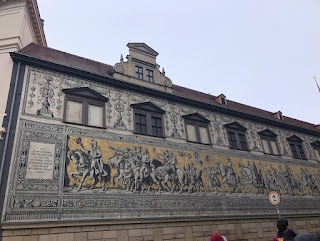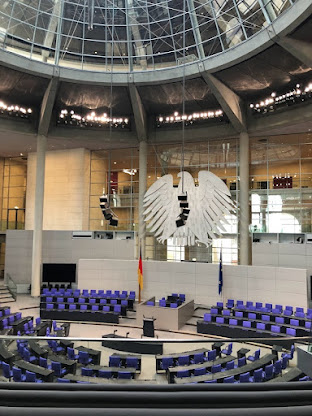Blocker Blog - Entry 4: The Case for Dresden
On one of our trips scheduled and organized by IES, we went to visit the city of Dresden for the day. We took the train, as one does here, early in the morning so that we would make the best of the day; despite the fact that it turned out to be one of the coldest days of the season by far, I was still very excited for the journey. According to Google Maps, the journey by train would take at least 3 hours; however in the train that we were in, time went by fast, which was something new for me since the US does not have the same capacity to have trains at high speeds, let alone a intricate railway system. Anyway, the journey was smooth and the views were interesting in the sense that it made me realize how this region in northern continental Europe was relatively flat to its southern side; also the flora was different from what I am familiar with, with an example being pine forest being bare on ground level.
Once we made it to Dresden we were given a brief tour of the city with the emphasis on the historic center. When it comes to the layout of the city, many buildings are very close together, which makes many people walk or bike to where they need to go; many streets were thin and paved with stones. The overall aura made it feel like the city has a long history with many old buildings still standing exceptionally well. However in our tour it was revealed that many of the buildings that we saw are reconstructions of the originals since Dresden, like many other German cities, were bombed and nearly destroyed during WWII; the same dark sandstone was used to rebuild churches, opera houses, palaces, opera houses, etc. This in my mind puts into conversation on how Dresden and its citizens take action into remembering their history whilst undoing the destructive aftermath of one of their darker chapters. I would later see different ways of acknowledging history from other cities in Germany as the semester continued.
The building that would further my thinking about the way Germany hosts and manages its multiple collections would be the Zwinger Palace, or the Zwinger for short. Built in 1709, the Zwinger is known for being a prime example of baroque architecture where it would first be a house for entertainment and festivities for German royalty. It would later be the place where scientific instruments would be stored and used by the intellectuals. During WWII it was nearly destroyed but was later reconstructed; today it hosts the Staatliche Kunstsammlungen Dresden, the oldest of its kind in the world. Despite its disruptive episode during the war, the building has a solid history where it has changed function and adapted to modern needs. When I compare this to many institutions similar back in the US, I believe that there are very few buildings or institutions as old that have reinvented itself over the years. The only place that I could think of that has a long history in the US would be The MET, which opened in the late 19th century. But even then, the building that is the MET has served only the one purpose throughout it history whilst an institution like the Zwinger has had a change of facades where it architecturally represents a legacy of a Baroque tradition. The Baroque style could be felt in many rooms and hallways through the Zwinger; many of the objects in the collections, like the Chinese porcelain collection, very much feel like decoration in a very fancy house instead of historical and important objects being portrayed in a blank room with standard spotlights.






Comments
Post a Comment